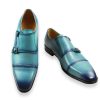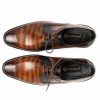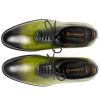The Art of the Hand-Sewn Apron: Where Craftsmanship Meets Timeless Style
For centuries, the hand-sewn apron has stood as the gold standard in fine shoemaking – a meticulous technique that transforms leather into wearable art. At Handsole, this heritage craft isn’t just a process; it’s the soul of our apron-front loafers. Here’s why this tradition remains unmatched in an era of mass production:
What is a Hand-Sewn Apron?
The apron refers to the distinctive folded leather panel covering a loafer’s vamp (forefoot). Unlike machine-stitched versions, a true hand-sewn apron involves artisans piercing leather with awls and stitching with waxed thread using a saddle-stitch technique. This creates:
-
Structural integrity: Double-threaded stitches that tighten over time
-
Artisanal character: Slight irregularities that signal human craftsmanship
-
Flexible durability: Stitches that move with the leather, not against it
*Fun fact: It takes 15+ years of training for a cordwainer to master the tension control needed for flawless apron stitching.
The apron is a defining style feature on many classic loafers, outlining a U-shaped panel on the toe that adds ornamentation and character to an otherwise plain vamp. Visually, this hand-sewn apron seam draws the eye and emphasizes the shoe’s moccasin-inspired heritage. Loafers that feature a visible stitched apron – especially in a casual material like suede – tend to project a more relaxed, informal elegance (a light suede loafer with a stitched apron is considered quite casual compared to a sleek, unadorned calfskin loafer). At the same time, executing this apron seam by hand elevates the aesthetic quality: experts note that a well-crafted hand-stitched apron generally looks superior to a machine-stitched one, owing to the finer, nuanced workmanship. In essence, the hand-sewn apron on a tassel loafer serves both as a stylish focal point and as a subtle signal of artisanal quality, enhancing the loafer’s visual appeal and personality.
The Handsole Hand-Sewn Process: 6 Steps to Perfection
-
Leather Selection: Only full-grain calfskin or suede with optimal pliability.
-
Pattern Cutting: Apron panels are cut on the bias for clean folding.
-
Skiving: Edges are hand-thinned to 0.6mm for seamless layering.
-
Awl Piercing: Holes are pre-punched to prevent leather tearing.
-
Saddle Stitching: Two needles weave waxed linen thread in opposing directions.
-
Hammer Setting: Stitches are gently tapped flat for a seamless finish.
Our artisans complete 180 stitches per apron – each taking 45 seconds of focused precision.
Beyond aesthetics, the hand-sewn whipstitch apron reflects functional craftsmanship in luxury shoemaking. Each stitch is placed by a skilled shoemaker, which means the apron is attached with strong, durable threading that can flex with the shoe. This method harks back to true moccasin construction, where hand-stitching was used for its strength and comfort. Modern tassel loafers that employ a hand-stitched apron carry on that tradition: the whipstitching tightly bonds the leather apron to the suede quarters, which can reinforce the structure of the loafer and enhance its durability, ensuring the shoe holds its shape through wear. The slight give in the hand stitching also allows the upper to mold comfortably to the foot over time, something rigid machine seams might not do as well. From an artisanal standpoint, visible hand stitching is a hallmark of luxury and heritage craftsmanship – it showcases the maker’s attention to detail and skill.
Why Hand-Sewn Beats Machine Stitching
| Hand-Sewn Apron | Machine-Stitched Apron |
|---|---|
| Stitches tighten with wear | Stitches loosen over time |
| Organic, nuanced appearance | Uniform but sterile look |
| Repairable by artisans | Often requires full panel replacement |
| 50+ year lifespan | 3-5 year lifespan |
| Develops character with patina | Shows wear as cracking/peeling |
3 Reasons the Apron Defines Luxury Loafers
-
Structural Brilliance
The apron isn’t decorative – it reinforces high-stress areas where feet bend. Hand-sewn construction allows strategic thread tensioning at flex points. -
The Patina Paradox
As botanically-tanned leather ages, hand stitches become more prominent, creating contrast shadow lines that machines can’t replicate. -
Silhouette Sorcery
A well-executed apron creates optical elongation, making feet appear leaner. Our square-toe apron loafers use this to modernize classic proportions.
Spotting True Hand-Sewn Aprons: A Buyer’s Guide
-
Look for: Slightly irregular stitch spacing (not robotic uniformity)
-
Touch test: Run fingers over stitches – they should feel embedded, not raised
-
Bend test: Creases should radiate from stitches like sunrays, not crack parallel to them
-
Brand mark: Seek terms like “saddle-stitched” or “double-needle hand-welted”
Pro Tip: True hand-sewn aprons always have stitches visible inside the shoe – machines can’t stitch through fully assembled uppers.
The Handsole Difference: Preserving a Dying Art
While 97% of “luxury” loafers now use hidden glue or machine stitching, our Cordovan Collection keeps tradition alive:
-
Apprenticeship program: Training next-gen artisans in Seville, Spain
-
Heirloom Guarantee: Free apron re-stitching for life
-
Traceable Leathers: Italian vegetable-tanned hides from ethical tanneries
Experience the craft: Explore Our Hand-Sewn Apron Loafers
In this loafer, the combination of a suede body with a smooth leather apron (and vamp) is carefully balanced by the apron’s hand-sewn detailing and the tassel accents. Using two different materials on one shoe can risk looking discordant, but here it creates a harmonious contrast. The suede’s soft, textured surface serves as a backdrop that makes the smooth leather apron pop. Meanwhile, repeating the smooth leather in the apron, vamp and tassels ties the design together – the tassels echo the apron’s material and color, creating a cohesive focal area on the front of the shoe. The whipstitched apron seam acts as a visual border between the suede and leather sections, ensuring a clear delineation that looks intentional and adds symmetry. This stitching line effectively frames the leather apron like a picture, so the eye is drawn to the center where the tassels lie, achieving a pleasing visual balance.
Why This Matters Beyond Aesthetics
Choosing hand-sewn isn’t just about shoes – it’s voting against disposable culture. Each pair:
✅ Preserves artisanal heritage
✅ Reduces landfill waste (repairable > replaceable)
✅ Supports ethical workshops over sweatshops
As master shoemaker Antonio Pérez says:
“The apron stitch is our signature – not ink on paper, but thread in leather. It says: ‘I was made with human hands to serve human feet.'”
Ready to wear art? Discover how our hand-sewn apron loafers redefine luxury: Handcrafted Collection
The visible hand-sewn apron on this loafer is a standout detail that showcases both artisanal heritage and functional beauty. Unlike machine stitching, this method relies on the shoemaker’s hand to execute each whipstitch along the apron seam — a process that reflects centuries-old craftsmanship. The raised whipstitch not only adds visual depth but also emphasizes the boundary between the smooth leather apron and the surrounding suede quarters. This combination of textures is framed by the stitch line, giving the loafer a clean, refined aesthetic.
Hand-sewn aprons are a signature element in bespoke and small-batch shoemaking, offering durability, flexibility, and unmistakable charm. They’re not just decorative — they allow the leather to contour naturally, increasing comfort and lifespan. Learn more about the benefits of hand-sewn construction in luxury shoes.
For more handcrafted details and similar apron stitching styles, explore our curated Apron-Toe Loafers Collection.












